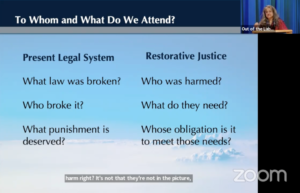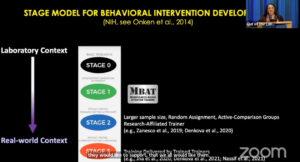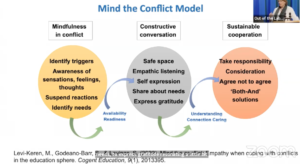The ultimate goal of scientific research is to have a positive impact on the world. While contemplation is rapidly gaining popularity, the path from empirical research to practical application has yet to be established. At the Symposium III of the Contemplative Science Summit jointly organized by Tianqiao and Chrissy Chen Institute (TCCI) and the University of California, Davis (UC Davis) on February 25, researchers drew on the experience of predecessors in bridging the gap between science and policy to explore how knowledge derived from contemplative science can play a role in social practices.
01 Law’s Middle Way: Contemplative presence and restorative justice
Sujatha baliga, J.D., Berkeley, California
Dr. Sujatha Baliga from the University of California, Berkeley shared the employment of contemplation in restorative justice.
The data suggests that out of 100 cases of sexual abuse against children, about 10 to 18 will be reported to the public security department, and only about 6 will end up being prosecuted and 3 convicted. This suggests that the criminal law system is not as effective as we think it is. In addition, imprisoning sex offenders at large scale can be incapacitating with limited effectiveness and may trigger retaliation. Inspired by Robert Yazzie and Howard Zehr (pioneers in the field of restorative justice), Dr. Sujatha Baliga believes that restorative justice can provide better protection for victims.

Howard Zehr defines restorative justice as an approach to justice that engages those who have a stake in a particular harm or crime, wherever possible, to identify and address the harms, needs, and obligations in order to minimize the harm. Whereas the present legal system focuses on “what law was broken”, “who broke it”, and “what punishment is deserved”, restorative justice focuses on “Who was harmed”, “what do they need”, and ”whose obligation is it to meet those needs”. The focus of restorative justice is not on punishment, but on repairing relationships.
Mindfulness and restorative justice practices can induce complementary paradigm shifts. Effective contemplation often alternates between deep attention and insight/epiphany, as is the case in peace mediation and other restorative justice dialogues. Those involved will participate in mindfulness training together to cultivate empathy and a sense of connection, while experiencing the whole process of restorative justice. Ultimately, this will give birth to a sense of interdependence. Individual and collective epiphanies ensue as deep, attentive listening transforms into empathy with the speaker.

Studies have shown that combining contemplative practices with restorative justice has effectively reduced crime rate by 44%, second offense rate by 33%, and improved victim satisfaction rate by 91%. In addition, restorative justice significantly reduced the cost of punishment.
02 Pay attention like your life depends on it: Advancing research on mindfulness training in real-world high-demand settings
Amishi Jha, Ph.D., University of Miami
Dr. Amishi Jha from the University of Miami shares the role of mindfulness training in highly stressful environment.
An increasing number of research has found that prolonged periods of high demands and stress will reduce cognitive functions such as attention and working memory. In the lab, multiple experimental paradigms such as the working memory task, the self-reported mind wandering task, and the sustained attention to response task have shown that when subjects are distracted, their performance on the task deteriorates significantly. In real life, when people are in a demanding and stressful environment for a long period of time, their attention and working memory will dive. And common relaxations such as listening to music and exercising are not effective in alleviating the decline in cognitive function. Mindfulness is a mental model that focuses on current experience without conceptual elaboration or emotional response. Research has shown that mindfulness training can help alleviate the decline in cognitive function of people under long-term high-pressure environments.

So, how do we advance mindfulness training in high-demand settings?
Dr. Amishi Jha suggests that one can learn from the stage model proposed by the National Institutes of Health (NIH stage model). In this stage model, working memory and attention are impaired in stage 0 (See above). The researchers will then propose an intervention program. In stage 2, the researchers will work with trainers to devise a suitable system that can be applied on other later. Additionally, Dr. Amishi Jha suggests that the capacity of communities to address important health issues can be improved by developing effective interventions that can be sustained over time (community-based participatory research, CBPR). Using a combination of these measures, Dr. Amishi Jha hopes to achieve the best practices of mindfulness training in a high-demand, real-world context.
03 Mindfulness training and peacemaking: Toward embracing reconciliation
Nava Levit-Binnun, Ph.D., Reichman University, Israel
Dr. Nava Levit-Binnun from Reichman University, Israel, shared how to incorporate mindfulness into interventions that promote effective deliberation and reconciliation. Dr. Nava Levit-Binnun comes from Israel, a country that has long faced many challenges, conflicts, and demonstrations, etc. As a result, how to get people out of these conflicts has become a pressing issue.
Mindfulness is an active process that combines attention and emotional regulation with challenging experiences. It enables people to explore and ultimately reevaluate challenging experiences as a source of meaning, thereby adapting to the environment and to others. Research by Nava Levit-Binnun’s team has shown that people who received mindfulness training will choose more adaptive regulatory strategies to cope with challenging situations. Mindfulness training affects the coordination of the body and brain, a process known as interception, which predicts health and how people will handle various situations. Mindfulness isn’t just an adjustment tactic, but an important approach when dealing with long-term, intractable conflicts.
Does mindfulness exert influence over the emotions associated with intractable conflicts, such as the Israeli-Palestinian conflict, and everything that goes with it? Nava Levit-Binnun’s research team recruited 101 Israeli Jews. Most of them were students who either had taken a course on mindfulness for stress reduction or waiting to receive relevant trainings. It turned out that the latter performed better than the former in self-reporting.

Can mindfulness training create conditions for cross-party communication? Research has shown that mindfulness training can help reduce the tendency to retaliate against injustice and provocations in the workplace, prejudice against minorities, and stereotyping and racial discrimination against external groups. Dr. Nava Levit-Binnun has proposed the Mind the Conflict Model, which brings contemplation into conflict situations in order to identify conflict triggers, perceive feelings and thoughts, and pause reactions to identify needs.
Can standardized mindfulness programs meet the needs of ethnic minorities or religious groups? The answer is positive. With cultural and social support, mindfulness training is expected to deliver effective support and empower minority groups in Israel.
Although the neural mechanisms by which mindfulness and contemplation benefit the mind and body requires further investigations, there is no doubt that it has gradually become an integral part of people’s lives by resolving individual and interpersonal difficulties and conflicts and has been integrated into society in a more meaningful and impactful way.